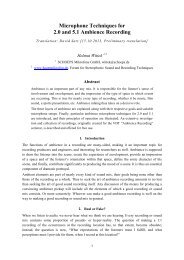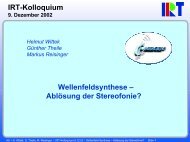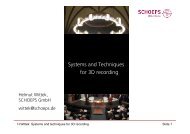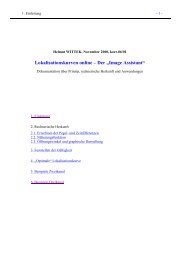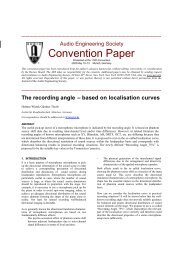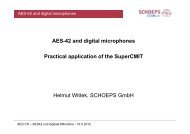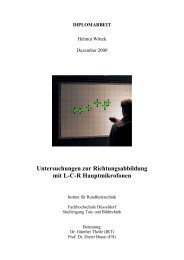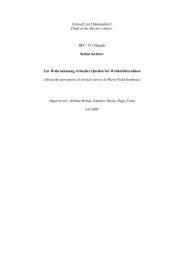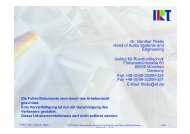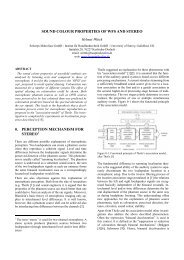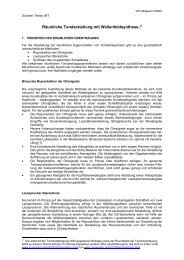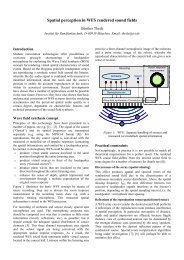on the localisation in the superimposed soundfield - Hauptmikrofon ...
on the localisation in the superimposed soundfield - Hauptmikrofon ...
on the localisation in the superimposed soundfield - Hauptmikrofon ...
You also want an ePaper? Increase the reach of your titles
YUMPU automatically turns print PDFs into web optimized ePapers that Google loves.
34<br />
DURLACH 1963, 1972 or <strong>the</strong> “correlati<strong>on</strong> model” by OSMAN 1971) <strong>the</strong>refore<br />
follow <strong>the</strong> locati<strong>on</strong> associati<strong>on</strong> stage.<br />
The model for pitch percepti<strong>on</strong> of complex sounds by TERHARDT 1972 agrees<br />
especially well with <strong>the</strong> associative process<strong>in</strong>g of <strong>the</strong> gestalt associati<strong>on</strong> stage. It is<br />
based <strong>on</strong> <strong>the</strong> assumpti<strong>on</strong> that<br />
“… <strong>the</strong> human hear<strong>in</strong>g system does not <strong>in</strong>herently know <strong>the</strong> difference between<br />
harm<strong>on</strong>ic and n<strong>on</strong>-harm<strong>on</strong>ic sounds. If <strong>the</strong> hear<strong>in</strong>g system is ‘<strong>in</strong> a natural state’,<br />
every sound is made up of a complicated comb<strong>in</strong>ati<strong>on</strong> of spectral pitches and<br />
perceived sound pressure fluctuati<strong>on</strong>s. … With <strong>the</strong> help of acquired knowledge<br />
of pitch relati<strong>on</strong>s between harm<strong>on</strong>ically related sounds and <strong>the</strong> perceived<br />
frequency of <strong>the</strong> sound pressure fluctuati<strong>on</strong>s, <strong>the</strong> hear<strong>in</strong>g system allocates a t<strong>on</strong>al<br />
mean<strong>in</strong>g to each presented sound. This t<strong>on</strong>al mean<strong>in</strong>g is perceived more or less<br />
dist<strong>in</strong>ctively as ‘virtual pitch’.” (TERHARDT 1972)<br />
The associati<strong>on</strong> model is compatible with this model, too. The source signals, which<br />
are discrim<strong>in</strong>ated by <strong>the</strong> effect of <strong>the</strong> locati<strong>on</strong> associati<strong>on</strong> stage, c<strong>on</strong>ta<strong>in</strong> all spectral<br />
<strong>in</strong>formati<strong>on</strong>. The percepti<strong>on</strong> (see def<strong>in</strong>iti<strong>on</strong> <strong>on</strong> page 29) of sound colour can occur <strong>in</strong><br />
terms of both proposed models.<br />
At this po<strong>in</strong>t, a localisati<strong>on</strong> phenomen<strong>on</strong> shall be po<strong>in</strong>ted out that so far has not been<br />
explicitly <strong>in</strong>vestigated. The sound colour of an auditory event turns out to be largely<br />
<strong>in</strong>dependent of <strong>the</strong> locati<strong>on</strong> of a sound event, even though <strong>the</strong> spectra of <strong>the</strong> ear<br />
signals are str<strong>on</strong>gly locati<strong>on</strong>-dependent (e.g. see BLAUERT 1974). To illustrate, a<br />
listener slowly turn<strong>in</strong>g by 180° <strong>in</strong> fr<strong>on</strong>t of a loudspeaker that is located <strong>in</strong> an anechoic<br />
chamber and that radiates white noise hardly perceives changes <strong>in</strong> sound colour when<br />
listen<strong>in</strong>g b<strong>in</strong>aurally.<br />
This phenomen<strong>on</strong> can easily be expla<strong>in</strong>ed by means of <strong>the</strong> effect of <strong>the</strong> locati<strong>on</strong><br />
associati<strong>on</strong> stage. As a result of <strong>the</strong> localisati<strong>on</strong> stimulus selecti<strong>on</strong>, <strong>on</strong>ly <strong>the</strong><br />
discrim<strong>in</strong>ated source signal reaches <strong>the</strong> gestalt associati<strong>on</strong> stage. It is not until here<br />
that <strong>the</strong> process for determ<strong>in</strong><strong>in</strong>g sound colour takes place.<br />
What effect does <strong>the</strong> model have <strong>in</strong> <strong>the</strong> <strong>superimposed</strong> sound field? To beg<strong>in</strong> with, this<br />
shall be illustrated for <strong>the</strong> phantom source situati<strong>on</strong>.<br />
A useful way of depict<strong>in</strong>g <strong>the</strong> effect is by means of “impulse diagrams”, which depict<br />
<strong>the</strong> temporal, b<strong>in</strong>aural characteristics <strong>in</strong> a simple manner. The well-known hypo<strong>the</strong>sis<br />
that <strong>the</strong> auditory system <strong>in</strong>itially evaluates each ear signal similar to an autocorrelati<strong>on</strong><br />
analysis (e.g. LICKLIDER 1951) but separately for narrow frequency<br />
bands (e.g. ZWICKER / FELDKELLER 1967, DUIFHUIS 1972, BLAUERT 1974,<br />
1978) justifies this illustrati<strong>on</strong> method. The relative positi<strong>on</strong>s of <strong>the</strong> maxima reflect<br />
<strong>the</strong> <strong>in</strong>teraural time difference for each frequency band (see Secti<strong>on</strong> 4.1). For <strong>the</strong>



